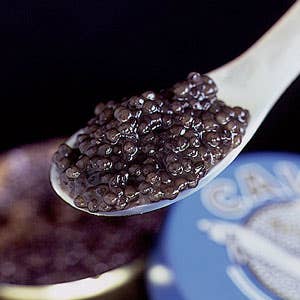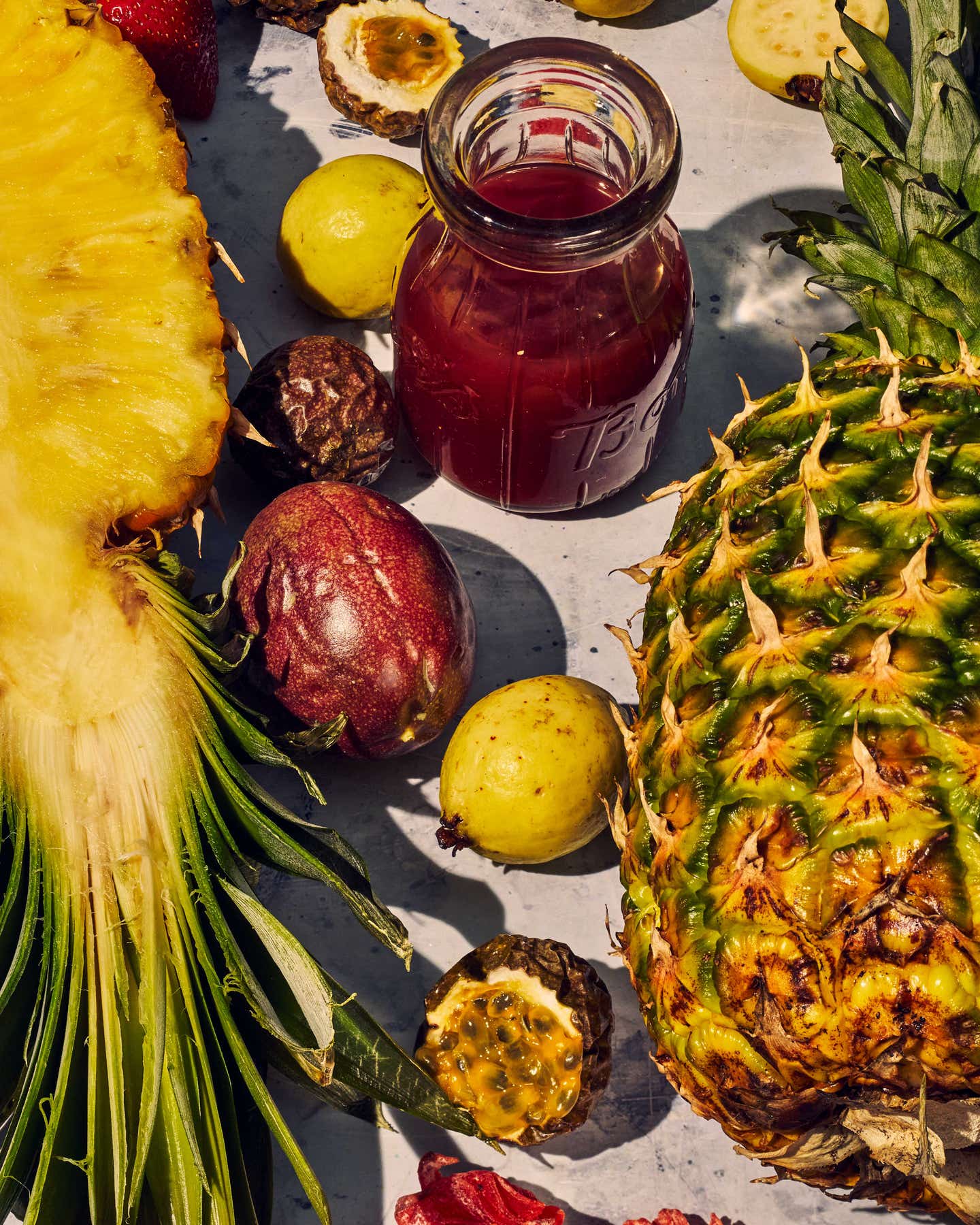
Caviar Dreams
It’s the glory of the Russian table, luxurious and romantic, but its future is as murky as the Caspian.
I've never tasted golden caviar, the legendary roe so rare that it was once reserved exclusively for Russia's tsars. I've learned to live with my deprivation, though, by indulging in whatever caviar is available, as often and as generously as my pocketbook allows.
The sturgeon's glistening ''black pearls'', whether spread gently on blini or piled on a piece of toast or eaten straight from a mother-of-pearl spoon—each egg popping delicately, and deliciously, in the mouth—have long been the stuff of legend and love, mystery and romance. The best caviar in the world comes from that exotic confluence of East and West, the oxbow on the Spice Route: the Caspian Sea and its tributaries. Back in the 11th century, fishermen who worked the Volga River, which flows south into the Caspian, had learned to prize the so-called krasnaya ryba, the ''beautiful fish'' of the sturgeon family. So valuable was this creature that local rulers employed ''sturgeon masters'' to oversee the procurement, preparation, and serving of the fish—both its flesh, and, as early as the 13th century, its roe.
Russians also ate the roe of burbot, white salmon, pike, carp, and grayling—but sturgeon roe, especially that from the varieties of fish known as beluga, osetra, and sevruga, was always considered the finest. Medieval Russians ate it hot (dusted with flour and fried, with onion, cranberry, or saffron sauce on the side) or cooked it and served it cold, sliced and flavored with herbal vinegar or mustard sauce. When it was eaten raw, it was usually seasoned with pepper, chopped onion, vinegar, and oil. In the early 19th century, culinary fashion called for slicing payusnaya—a strong-flavored caviar paste made from damaged or overly mature sturgeon roe—and presenting it in a napkin as salfetochnaya, or ''serviette caviar''. (Payusnaya had another, unexpected use: Elena Molokhovets, who might be called the Russian Mrs. Beeton, counseled using it instead of egg whites to clarify bouillon.)
Later in the 19th century, it became common practice to serve caviar in the modern style, uncooked and unadorned. In Home and Housekeeping (1897), Marie Redelin gave her Russian readers permission to simply pile caviar—the large gray grains of Astrakhan caviar, she said, were best—on toast points. By that time, too, an international market for Russian caviar had developed. In 1896, Russia exported 23,000 poods (about 828,000 pounds) of it, mostly to Europe. Taking note of Russia's successful caviar trade, Iran, on the southern shores of the Caspian, developed its own caviar industry, which flourished until the fall of the Shah. At the time, there were also caviar industries in other parts of the world, such as Italy and Germany (sturgeon were caught in the Po and Elbe Rivers, respectively) and the United States, then the largest caviar producer outside Russia. Henry Schacht, an enterprising immigrant, founded the American caviar business in 1873 with Delaware River sturgeon. For a time, this caviar was so abundant that saloon owners offered it free to patrons, hoping it would increase their thirst for whiskey and beer. Soon after 1900, though, overfishing and pollution had seriously depleted the American sturgeon population, and Russian caviar began to be imported into the U.S.
Today, about 90 percent of the world's sturgeon catch comes from the Caspian Sea region. But recent reports from the area are alarming. Not only has pollution sullied the Caspian's waters, threatening its sturgeon with extinction, but rampant poaching and overfishing are further reducing sturgeon stocks. The problems, both natural and man-made, are manifold. For instance, water levels in the Caspian have fallen significantly, shrinking its surface area and leading to the loss of important sturgeon spawning and feeding grounds. The Caspian has been rising again since 1978, but stocks of commercially important fish, including sturgeon (the huge beluga sturgeon, in particular) are not expected to recover significantly.
The Caspian region also suffered from the heedless industrialization of the Soviet era, when many hydroelectric stations and dams were built on the rivers feeding into the sea. Another problem is exploitation of the Caspian's other natural source of wealth—oil, which yields even greater profits than caviar. Concentrations of residual oil in the sea have contributed to a severe decline in the growth rate, maturation, and reproductive capacity of the native sturgeon. Further burdened by the unchecked inflow of agricultural and waste waters, the Caspian can no longer clean itself, and its plankton, the sturgeon's major source of food, cannot easily photosynthesize.
Official caviar production has fallen off drastically, some 75 percent between 1984 and 1994, according to reports by the World Wildlife Federation. And the sanctioned factories that do continue to produce caviar are struggling to survive. Last July, when I was in Russia, the processing collective in Primorsko-Akhtarsk, a port on the Sea of Azov, was in the news. Supposedly caviar output here has dwindled to a mere trickle—a quarter of what it was just five years ago—and the workers had not been paid for six months. Many believe that the only way for the workers to feed their families is by selling caviar on the side.
That's the tame side of black marketeering. Serious poaching is another story, however. Most illegal sturgeon fishing takes place not in Russia proper, but in the former Soviet republics, especially Dagestan. Until 1990, illegal caviar was generally shipped from the Caspian's shores by train to Moscow and then dispersed throughout Europe. But after Russia invaded Chechnya, poachers found a welcome reception there, and a major transit route for contraband now goes through Chechnya. Illegal harvesting by these cartels costs Russia such vast sums in lost revenues that the government has responded by sending in OMON, its special forces, to battle the poachers. But it's not simply a question of government versus swindlers. The various peoples native to the Caspian Sea region are largely united in their hatred of the Russians, their colonial masters for centuries, and have banded together to fight an economic, as well as a political, war against them. Last summer, Russia attempted to close the border between Dagestan and Chechnya to curb the illegal flow of weapons, narcotics—and caviar. Nationalist strife spinning out of control could become devastating to the Caspian sturgeon.
On the other hand, the Russian government announced recently that all of the countries surrounding the Caspian had signed an accord (proposed last spring by officials in the Russian fishing industry) prohibiting open-sea sturgeon fishing. This is an extension of the long-standing Russian policy of fishing only in the region's rivers. It constitutes a concerted effort to curb poaching, but exactly how it is to be enforced remains in question. Meanwhile, geneticists are trying to create a hardier sturgeon species, based on the bester, a cross between the beluga and the sterlet. To further protect the sturgeon supply, as of April 1, the Convention on the International Trade of Endangered Species (CITES) will require all caviar importers in the U.S. to secure permits from their caviar suppliers, thus forcing the suppliers to better document where their roe is coming from.
The economics of the battle are daunting, though. When I was in Russia recently, the government would not allow black caviar to be sold on the foreign market for less than $400 a kilo, with most of that profit going into state coffers. But a poacher can easily sell a kilo of caviar on the black market for a tidy $100, which is his to keep. Dealers realize even greater gains. At a Moscow grocery store, I legally bought four ounces of beluga for $76. But at the farmers' market, I was able to find eight ounces of fresh be-luga for only $31—and if I'd chosen to buy in bulk, I could have purchased half a liter for just under $100, about $6.60 an ounce.
Buying the contraband caviar was an adventure in itself. Although caviar was nowhere in evidence at the market, piles of oily yellow sturgeon hinted that there might be other, hidden treasures. When I asked one saleswoman if she had any caviar, she gave me a good looking-over—then brought out several jars and offered me samples, heaping shiny eggs from one batch after another on the back of my hand. I eagerly tasted them all, deeming one too salty, another too oily, before deciding on the perfect one. I paid, then asked the woman if I could photograph her. She scolded me for even asking. ''Don't you know this is contraband?'' she chided. ''Do you want to send us to jail?'' Another saleswoman was more accommodating and offered to pose for $500. On my budget, I had to decline.
How can an American caviar lover be certain he or she is getting good, honest caviar? The best thing to do at this point is simply to find a reliable supplier. One can also experiment with other caviars, like that from China, where a fine caviar is produced from Amur River sturgeon, or California, where a white sturgeon is bred specifically for its roe. There is also Romanian caviar, new on the scene and made from Black Sea sturgeon caught in the Danube River.
I've never been enthusiastic about these substitutes myself. As much as I adore caviar, mine is not a purist's appreciation, and I enjoy it not so much for the pleasure of pressing each oily grain against the roof of my mouth, or for its sweet, briny flavor, but for its associations with the past—the legends, the literature, the lavishness lacking in my own daily life. Only Caspian caviar provides such a blissful reward, and the cost, I've decided, can never be too high.
Keep Reading
Continue to Next Story










